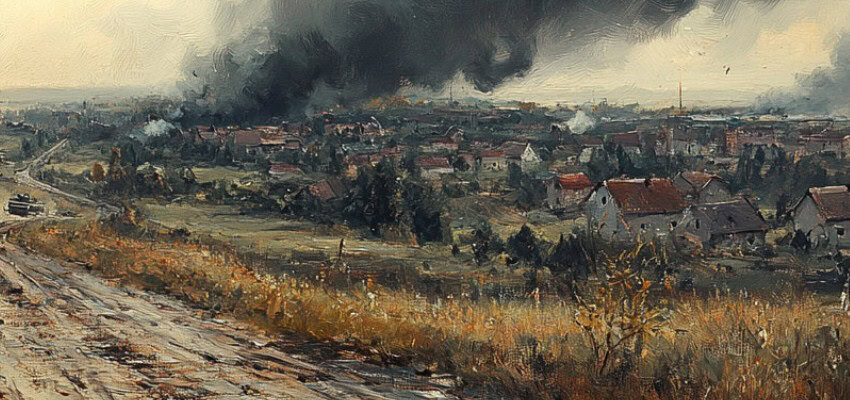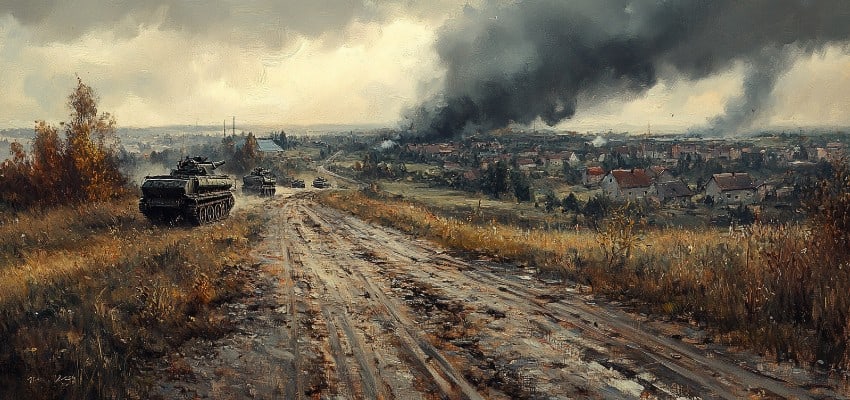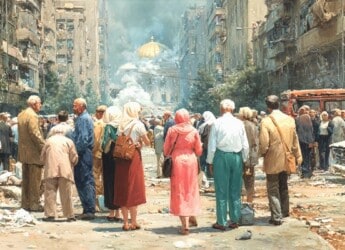Editor’s Note: This report provides a detailed narrative of the recent developments in the ongoing conflict between Russia and Ukraine as of August 31, 2024. It analyzes key military movements, strategic redeployments, and the broader implications of the conflict, offering insights into the operational challenges faced by both Russian and Ukrainian forces. This analysis draws on the latest intelligence and updates from the Institute for the Study of War (ISW) and aims to provide a clear, factual account of the current situation on the ground.
For those seeking to grasp the full scope of this evolving landscape, the complete updates from the Institute for the Study of War serve as an invaluable resource.
Content Assessment: Ukraine's Unyielding Pressure Prompts Russian Military Adjustments
Information - 92%
Insight - 91%
Relevance - 90%
Objectivity - 93%
Authority - 94%
92%
Excellent
A short percentage-based assessment of the qualitative benefit expressed as a percentage of positive reception of the recent Ukraine conflict update from ComplexDiscovery OÜ as prepared from Institute for the Study of War reports.
Background Note: ComplexDiscovery’s staff offers distinctive perspectives on the Russo-Ukrainian war and Iran-Israel conflict, informed by military experience on the West German, East German, and Czechoslovakian border during the Cold War and in Sinai as part of Camp David Accord compliance activities. This firsthand regional knowledge has been further enhanced by recent staff travels to Eastern European countries, including Estonia, Latvia, Lithuania, and Poland. These visits have provided up-to-date, on-the-ground insights into the current geopolitical climate in regions directly impacted by the ongoing conflict.
Combined with proficiency in cybersecurity, information governance, and eDiscovery, this multifaceted experience enables comprehensive analysis of these conflicts, including the critical impact of cyber warfare, disinformation, and digital forensics on modern military engagements. This unique background positions ComplexDiscovery to provide valuable insights for conflict-related investigations and litigation, where understanding the interplay of technology, data, and geopolitical factors is crucial.
Russo-Ukrainian Conflict Update*
Ukraine’s Unyielding Pressure Prompts Russian Military Adjustments
ComplexDiscovery Staff
The situation on the ground in Ukraine as of August 31, 2024, reveals a highly dynamic and challenging environment for both Russian and Ukrainian forces. The ongoing conflict continues to evolve, with significant developments that have substantial implications for military strategies on both sides.
The Russian military command appears to be grappling with operational pressures resulting from Ukrainian incursions into Kursk Oblast. In response, Russia has redeployed elements originally intended for priority offensive operations in the Pokrovsk direction to bolster defenses in Kursk. Specifically, units from the Russian 15th Motorized Rifle Brigade, previously engaged near Pokrovsk, have been moved to Kursk Oblast, underscoring the strain on Russian forces as they attempt to manage multiple fronts. This redeployment highlights the broader operational challenges faced by the Russian military, as it struggles to maintain momentum in its primary areas of focus while addressing emerging threats elsewhere.
Despite these redeployments, Ukrainian forces have continued their assault operations in Kursk Oblast. However, these efforts have yet to result in significant territorial gains. Reports from Russian sources indicate various localized skirmishes, but the frontlines have largely remained unchanged. The persistence of Ukrainian assaults, even in the absence of major breakthroughs, demonstrates Kyiv’s ongoing commitment to applying pressure on Russian defenses across multiple sectors.
In a parallel development, the Russian military command has undertaken a significant reorganization of the Donetsk and Luhansk People’s Republics’ army corps. The 1st and 2nd Army Corps have been restructured into two new combined arms armies, designated the 51st and 3rd CAAs, respectively. This restructuring is likely aimed at enhancing the operational effectiveness of these units, reflecting Russia’s broader strategy to consolidate and strengthen its military presence in occupied Ukrainian territories.
Concurrently, Russian forces have continued their offensive operations in key areas such as Chasiv Yar, Pokrovsk, and Donetsk City. These operations have yielded some marginal gains, particularly near Chasiv Yar, where Russian forces have advanced into eastern Hryhorivka. Despite these localized successes, the overall strategic impact remains limited, as the conflict continues to be characterized by a grueling and protracted battle for control.
The Russian military is also reportedly facing significant challenges related to manpower and equipment shortages. These shortages have hampered Russia’s ability to operate at full strength, a situation exacerbated by the Kremlin’s ineffective wartime policies and the heavy losses sustained in earlier phases of the conflict. The reliance on underprepared and ill-equipped units further illustrates the difficulties encountered by the Russian military as it seeks to sustain its offensive operations.
Amid these military developments, Ukrainian Defense Minister Rustem Umerov has drawn attention to the continued use of Russian airfields within the range of Ukrainian ATACMS missiles. Despite restrictions imposed by the United States on Ukraine’s use of American-provided weapons to strike targets inside Russia, these airfields remain operational, allowing Russia to maintain sanctuary spaces in its deep rear areas to support ongoing military operations against Ukraine.
At the same time, the Kremlin has intensified efforts to codify a state ideology rooted in traditional and cultural values. President Vladimir Putin has tasked the Presidential Administration’s Directorate for State Humanitarian Policy with overseeing the preservation of Russia’s “spiritual and moral foundations.” This initiative is part of a broader effort to solidify a state ideology, a move that circumvents the Russian Constitution’s prohibitions against establishing a state ideology and recognizing ideological diversity.
In response to the evolving nature of the conflict, the Ukrainian Armed Forces have officially established the Unmanned Systems Forces, appointing Captain First Rank Roman Hladkyi as the Chief of Staff. This development is indicative of Ukraine’s ongoing efforts to modernize its military capabilities and enhance its technological edge in the face of Russian aggression.
On the technological front, Russia continues to introduce innovations aimed at countering Ukrainian military capabilities. A notable example is the development of a device designed to combat drones using lasers, which could potentially enhance Russian defense measures against Ukrainian unmanned aerial systems. This innovation is part of Russia’s broader effort to adapt technologically in response to the challenges posed by the Ukrainian military.
The Kremlin’s mobilization and recruitment efforts continue to face significant challenges. Public disinterest and the government’s failure to establish a consistent mobilization system have hindered recruitment efforts. In an attempt to address these issues, regional programs are being implemented to integrate veterans into local governments, likely as a strategy to boost recruitment rates and maintain military morale. Despite these efforts, the Russian military continues to struggle with the realities of sustaining a prolonged conflict.
Overall, the situation in Ukraine remains complex and fluid, with both Russian and Ukrainian forces facing significant challenges. The redeployment of Russian forces, the restructuring of military units, and the ongoing offensive operations all point to a conflict that is far from resolution. Both sides are engaged in a battle of attrition, with incremental gains and losses shaping the broader strategic landscape. As the conflict drags on, the geopolitical implications, including Russia’s attempts to solidify a state ideology and Ukraine’s focus on technological modernization, continue to underscore the multifaceted nature of this war.
News Sources
As a leading source for cybersecurity, information governance, and legal discovery insights, including international investigations and litigation, ComplexDiscovery OÜ recognizes the importance of awareness regarding alleged and documented criminal acts, particularly in the context of the Russia-Ukraine conflict. While we, following the lead of the Institute for the Study of War (ISW), do not provide detailed coverage of war crimes in our primary reports, we encourage professionals within the eDiscovery ecosystem to stay informed about these activities. This awareness is crucial for understanding potential future legal actions and responsibilities.
Detailed Reporting with Maps for August 31, 2024, from the ISW – Mouseover to Scroll
Russian Offensive Campaign Assessment - 083124Review the Detailed Reporting and Maps PDF
About the Institute for the Study of War Research Methodology
ISW’s research methodology relies on both primary and secondary sources, enabling researchers to develop a comprehensive understanding of the situation on the ground. In order to analyze military and political developments in any given area, ISW’s research analysts must wholly understand the systems of enemy and friendly forces. They must also understand the population demographics, physical terrain, politics, and history of that area. This lays the analytical foundation for understanding the reasons for particular developments and fulfilling their assigned research objectives. ISW analysts also spend time in places like Iraq, Afghanistan, and elsewhere in order to gain a better understanding of the security and political situation and to evaluate the implementation of current strategies and policies. Our researchers compile data and analyze trends, producing a granular analysis of developments in areas of research, producing an accurate, high-resolution, timely, and thorough picture of the situation. ISW’s research methodology guarantees its success and commitment to improving the nation’s ability to execute military operations, achieve strategic objectives, and respond to emerging problems that may require the use of American military power.
About the Institute for the Study of War
The Institute for the Study of War advances an informed understanding of military affairs through reliable research, trusted analysis, and innovative education. They are committed to improving the nation’s ability to execute military operations and respond to emerging threats in order to achieve U.S. strategic objectives. ISW is a non-partisan, non-profit, public policy research organization.
Learn more, get involved, and contribute today.
Additional Reading
- From Dissent to OSINT? Understanding, Influencing, and Protecting Roles, Reputation, and Revenue
- [Annual Update] International Cyber Law in Practice: Interactive Toolkit
- Data Embassies: Sovereignty, Security, and Continuity for Nation-States
Assisted by GAI and LLM Technologies
* Sourced and shared with direct express permission from the Institute for the Study of War (ISW).
Source: ComplexDiscovery OÜ



























